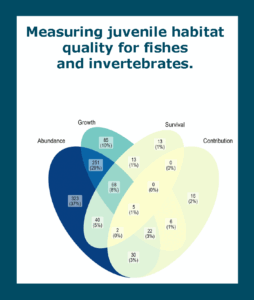Identifying the role of marine and estuarine habitats in supporting fish and invertebrate populations during vulnerable juvenile life stages is essential to achieve effective conservation and fisheries management. There remains general agreement that: ( i ) the quality of juvenile habitat is best measured as the contribution of juveniles to adult populations (here “juvenile–adult contribution”) and ( ii ) this contribution may be measured directly or inferred from habitat‐specific abundance, growth and survival. Obtaining effective estimates of juvenile habitat quality using these four metrics, however, is challenging. Through a systematic review of approaches to measure juvenile habitat quality, we critically evaluate current abilities to identify key habitats and provide recommendations for future work. We found that research in this area remains dominated by measurements of abundance (85% of studies) and, to a lesser extent growth (51% of studies), with limitations in the spatiotemporal resolution and extent of sampling. Relatively few approaches are available to measure survival and juvenile–adult contribution. Knowledge of juvenile habitat quality is further limited by restricted coverage of geographic areas, taxonomic groups and habitats. Based on our analysis of 874 studies over the past ca. 50 years, we provide five recommendations for enabling juvenile habitat research to support fisheries and conservation management better in future.
